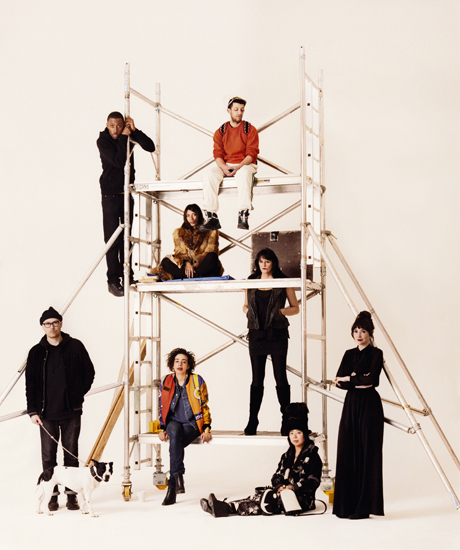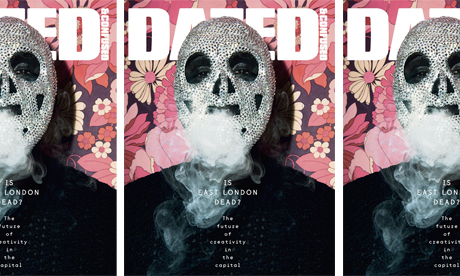Dazed and Confused: East London’s creatives face uncertain future

Dazed & Confused Magazine. Photography By Jamie Hawkesworth. Clockwise From Top Left: Elijah Butterz, Nasir Mazhar, Tracey Moberly, Kathryn Ferguson, Yang Du, Martine Rose, Missy The Dog, James Edson, Charlotte Jansen
Once upon a time it was East End or bust for London’s creative types, the streets of Hackney a Mecca for bequiffed artists in skinny jeans wielding heavy-duty cameras.
And while that stereotype may still hold some truth, redevelopment and the spectre of the Olympic Games mean things could be about to change.
An article in this month’s Dazed & Confused magazine takes a look at London’s creative capital, and asks the question: “Is East London dead?” We talked to Dazed’s editor Rod Stanley and lead feature writer Tim Burrows about their findings.
HC: Why have you chosen this particular juncture to cover the East End?
Rod: The Dazed offices have been on Old Street for a long time, and the mag is strongly associated with the long-established creative scene of London’s East End.
The process of redevelopment we are investigating has of course been happening for a long time, but we felt the Olympics were such a visible symbol of how much the area has changed that it provided a suitable moment to take stock, and ask what this process means for the artists, musicians and various other creative types that made the area their home over the last couple of decades.
Tim: This summer seems to be the agreed upon ‘point of no return’ in terms of discourse about east London, largely due to the looming Olympic Games.
Artists such as Laura Oldfield Ford, whom I talked to for the piece, have been using the date as a kind of endgame for a certain logic, this land grab mentality to East London planning which has resulted in Westfield mega-mall in Stratford taking over a huge swath of land.
HC: How far out do you think the cultural centre of gravity of East London might eventually shift?
Rod: At some point, the further one has to go out east to find more affordable rents, workspaces etc. will be further away than equivalent spaces in other parts of London closer to the centre.
At which point, one can reasonably expect to see some migration – some of those spoken to in our issue see this already happening. Others suggest that there is a long way to go yet and that the East End will remain core to the capital’s cultural scene for some time yet to come.
Tim: There is obviously a limit to how far you can go before it ceases to be East London and becomes Greater London and Essex – but potentially it could shift a lot further.
Stratford, West Ham, Leyton and Walthamstow were Essex until the 1960s. There is no reason why it can’t go on and on but there may come a time when the label ‘East End’ is less relevant in terms of being shorthand for a kind of creative cool, depending on where the young artistic demographic moves next.
HC: Would it be worth trying to preserve the artistic scene that appears to be on the wane, or are geo-specific artistic phenomena not in any case doomed to be transient?
Rod: I don’t think these things can be forced. Cities, and London in particular, are in constant upheaval, which is part of what makes them so interesting.
And besides, if we are talking about protecting certain aspects of areas from development, there are more important issues to do with people’s lives like local housing, education, employment and so on … these artistic scenes tend to be transient and find and use the gaps and empty spaces around people’s lives. Nothing lasts forever, and nor should it.
Tim: In a way it’s probably right that these bursts of creativity are fleeting. For music venues and the like, if you need to work too hard to preserve them, it’s probably too late.
It’s a symptom of the finance-driven logic of London, which seems to relegate ‘the artist’ to the role of property developers’ helpers, making an area attractive for a more affluent demographic to fill in a few years’ time. It is what I tried to convey in the piece, that artists are complicit in gentrification, even though it doesn’t make it less painful for them when they are forced out of the places they loved.
HC: With digital technology playing an increasing role in virtually all art forms, might the rise of Tech City in Shoreditch not be a bonus for those creatives who can afford to remain there?
Rod: It might be. We may snigger at the terminology of ‘Silicon Roundabout’, but the proliferation of digital start-ups in the area is not a bad thing – it is merely another sign of the changing nature of the area. But would these start-ups directly benefit artists etc. that remain in the area? I don’t really see much of a direct connection in that sense.
—
More from Dazed and Confused at Dazed Digital.

Dazed & Confused Magazine: on sale now. Photo credit: Artist Theo-Mass Lexileictous; shoot by Swiss art photographer Walter Pfeiffer; styling by Dazed senior fashion editor Robbie Spencer
